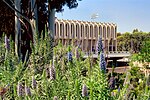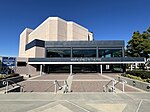UCI Arboretum
Arboreta in CaliforniaBotanical gardens in CaliforniaOrange County, California geography stubsProtected areas of Orange County, CaliforniaUnited States garden stubs ... and 1 more
University of California, Irvine

The University of California, Irvine Arboretum (UCI Arboretum or UC Irvine Arboretum) is a 12.5 acres (5.1 ha) botanical garden and arboretum, part of the University of California, Irvine in Irvine, California. It is located north of the main UCI campus, on Campus Drive in Irvine, near the San Joaquin Wildlife Sanctuary and the Upper Newport Bay. The Arboretum carries out conservation activities and supports student and faculty research.
Excerpt from the Wikipedia article UCI Arboretum (License: CC BY-SA 3.0, Authors, Images).UCI Arboretum
Jamboree Road, Irvine UCI - North Campus
Geographical coordinates (GPS) Address Nearby Places Show on map
Geographical coordinates (GPS)
| Latitude | Longitude |
|---|---|
| N 33.6635 ° | E -117.853 ° |
Address
Jamboree Road 19172
92612 Irvine, UCI - North Campus
California, United States
Open on Google Maps




